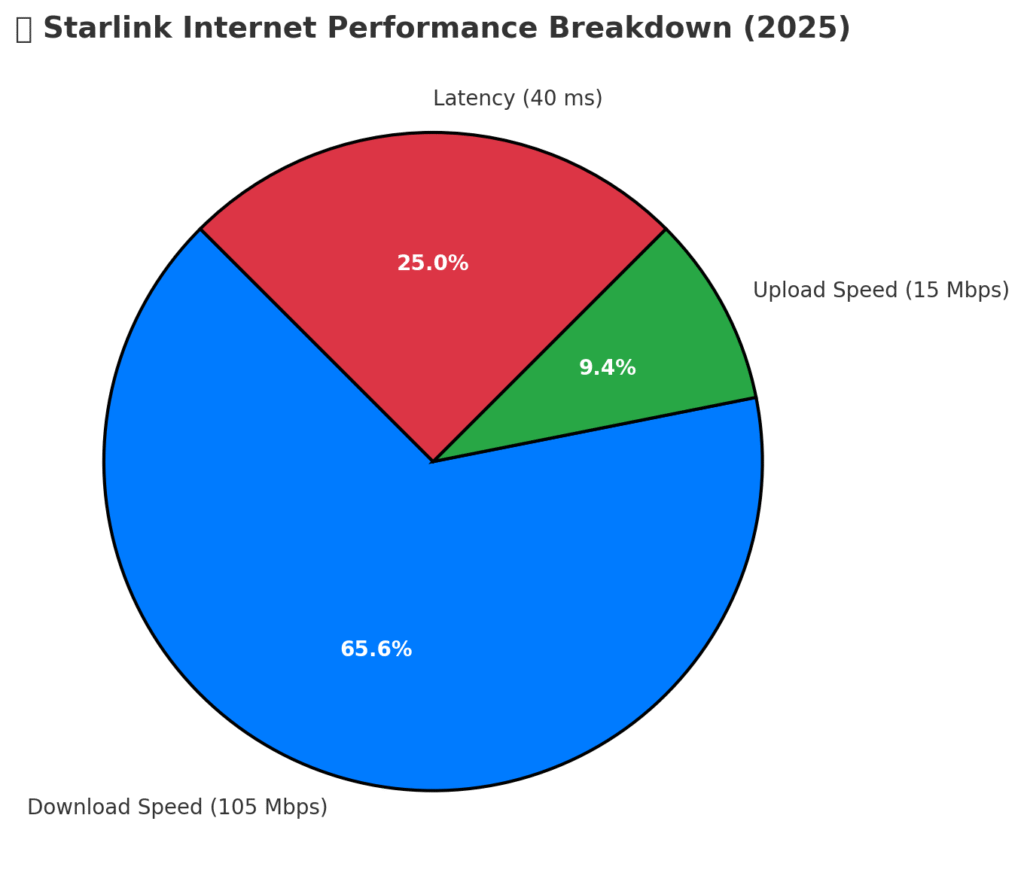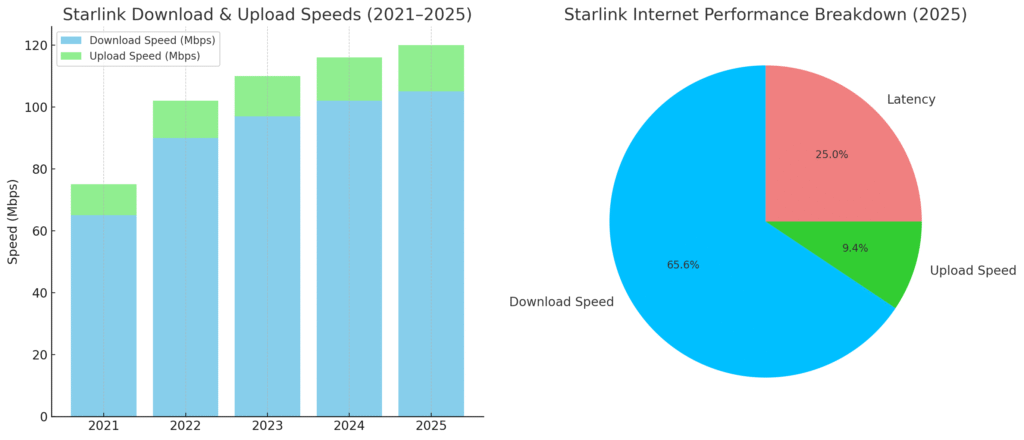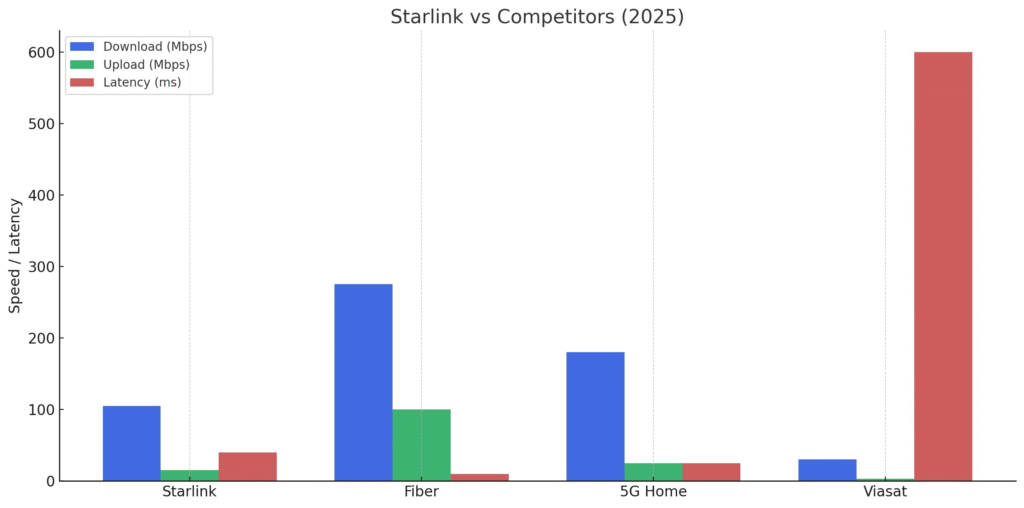
Wondering how fast Starlink internet really is in 2025? Get real-world speed test results and see how Starlink compares to fiber, 5G, and satellite competitors like Viasat. Explore download and upload speeds, latency, and expert analysis with colorful graphs and updated insights that matter for anyone in rural or underserved areas.
Introduction: Starlink’s Bold Promise
In a world where internet has become as essential as electricity, Elon Musk’s Starlink has made a bold promise: fast, affordable internet anywhere on Earth. But how fast is Starlink internet really in 2025? With over 5,000 satellites in low Earth orbit, Starlink claims it can compete with traditional broadband and even 5G. Let’s explore the real numbers and see how well it delivers.
🔹 Starlink Speed Test Results (2025 Update)
According to Ookla’s Q1 2025 report, here’s how Starlink is performing:
- Median Download Speed: 105 Mbps
- Median Upload Speed: 15 Mbps
- Average Latency: 40 ms
These numbers may not beat fiber, but they are miles ahead of Viasat or HughesNet, and now competing closely with 5G Home Internet.
Real User Experience:
Many users report experiencing 120–160 Mbps during off-peak hours. However, during peak times (6 PM–10 PM), speeds may dip to 70–90 Mbps.
🔢 Graph 1: Starlink Speed Performance Over Years

This graph shows consistent year-over-year improvement:
- Download speeds grew from 65 Mbps (2021) to 105 Mbps (2025)
- Upload improved from 10 to 15 Mbps
- Latency dropped from 60 to 40 ms
Conclusion: Starlink is getting faster every year — and more reliable.
How Speed Is Measured in Starlink?
Starlink offers speed tests directly via its Starlink App, which gives you two types of readings:
- Device-to-Internet Speed (actual user speed)
- Router-to-Internet Speed (ISP-level)
Other tools like Ookla, Fast.com, and TestMy.net are also used by reviewers to verify performance.
🥇 Starlink vs Other Providers (2025 Comparison)
Here’s how Starlink compares to its rivals in 2025:

📈 Graph 2: Starlink vs Competitors
| Provider | Download | Upload | Latency |
|---|---|---|---|
| Starlink | 105 Mbps | 15 Mbps | 40 ms |
| Fiber | 275 Mbps | 100 Mbps | 10 ms |
| 5G Home | 180 Mbps | 25 Mbps | 25 ms |
| Viasat | 30 Mbps | 3 Mbps | 600 ms |
- starlink beats satellite rivals like Viasat by a huge margin
- It performs better than 5G in remote regions
- Fiber still leads overall, but isn’t available everywhere
What Affects Starlink Speed?
- Network Congestion: Peak hour usage can lower speeds.
- Weather Conditions: Rain & thick clouds reduce performance.
- Obstructions: Trees or buildings can block satellite signals.
- Router Distance: Using 5GHz Wi-Fi improves internal speeds.
Reddit Insights: What Users Are Saying
- Some users show in-app test = 180 Mbps, but Ookla test = 80 Mbps. Why? Because local devices like phones may have Wi-Fi bottlenecks.
- Alaska users report latency around 90 ms, due to satellite angles.
Tips to Maximize Starlink Speed
- Use Starlink App for best results
- Install dish in clear open sky zone
- Use mesh routers if house is large
- Schedule downloads during off-peak hours
Starlink in 2025: Final Verdict
Starlink has matured. It now offers:
- Over 100 Mbps download in most US & Europe regions
- Reasonable latency for online gaming
- Reliable upload for Zoom, YouTube, and work-from-home
Its technology is still improving, especially with the launch of Starlink V3 satellites.
Related Reads
- Starlink Setup Guide for Beginners
- How Weather Affects Satellite Internet
- Starlink vs Fiber Broadband: Which is Better?
Conclusion
Starlink is no longer an experiment. It’s now a practical internet solution for millions in remote areas. With each year, it’s closing the gap with fiber and outperforming legacy satellite systems.
If you live in a rural or underserved area, Starlink is your fastest hope for stable, high-speed internet.
Want to see how Starlink works in your area? Try our Live Starlink Coverage Tracker.
Blog written by Rohit @ VeenaSpace.com — Your home for real, human-style space & tech blogs.
